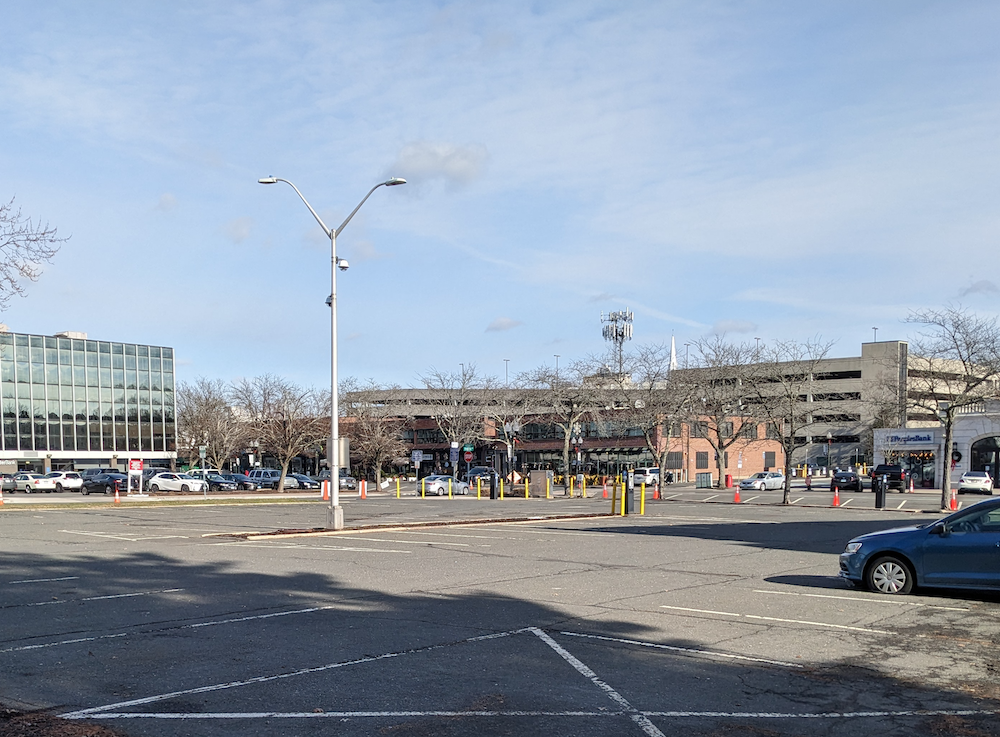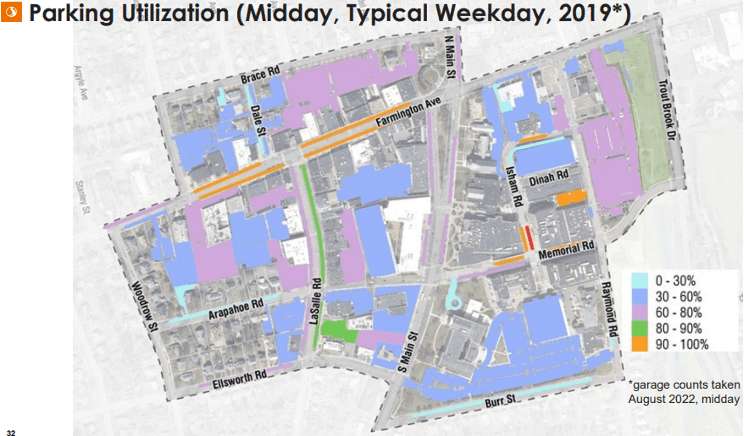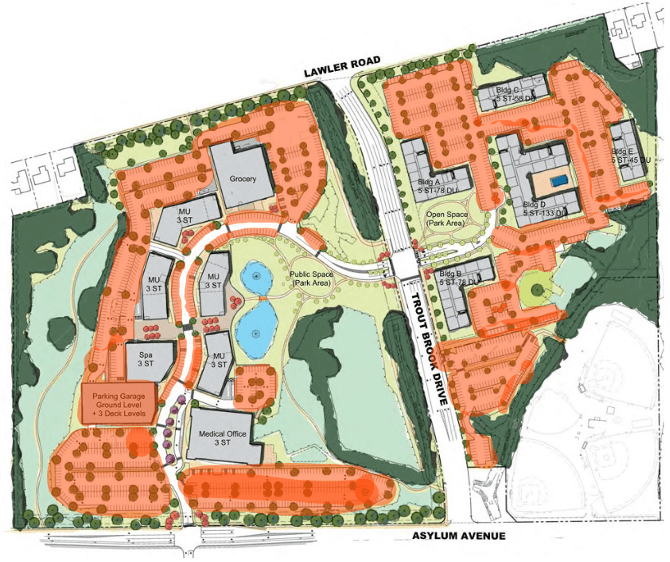Letter: Let’s Eliminate Minimum Parking Requirements in West Hartford

Audio By Carbonatix

Parking lot at corner of Arapahoe and LaSalle Road in West Hartford. Courtesy photo
We-Ha.com welcomes Letters to the Editor from the public, including endorsements. Letters submitted by political candidates will be considered for publication up to 14 days prior to an election and most will be published within 48 hours of receipt. Letters that contain personal attacks or include profanity of any type will not be published. Rebuttals to letters should be submitted as a separate document, and commenting on letters will no longer be permitted. Please provide your full name and town, as well as your phone number at the end of the letter. Phone numbers will not be published but are required in case verification is needed. Please submit letters to [email protected].
An Open Letter to the West Hartford Town Council and West Hartford Planning and Zoning Division:
We urge the Town of West Hartford to abolish minimum parking requirements. Minimum parking requirements are zoning regulations that mandate a certain number of parking spaces be provided for each new development. These requirements unnecessarily dictate the shape of real estate development in our town.
The town will hold a public hearing on Tuesday June 13, 2023 at 7 p.m. in Town Hall Room 314 on a proposed Ordinance Amending Residential Parking Requirements. While the purpose of this hearing is to make minor adjustments to minimum parking laws, we call for a serious reexamination of these relics of the past. Even the town’s proposed ordinance states that “lowering residential parking minimums has many public benefits, including but not limited to promoting a diversity of residential buildings, more efficient design concepts, better use of space, increased density, and less automobile dependency.” So let’s get serious about making significant and impactful changes. West Hartford should take this opportunity to join other forward-looking communities – including Burlington, VT, Buffalo, NY, and Hartford and Bridgeport here in Connecticut – by abolishing minimum parking requirements entirely.
There are a number of problems with minimum parking requirements, including:
- Minimum parking requirements suppress economic development. CNN recently estimated that building one parking spot can cost $26,000. According to the American Planning Association, minimum parking requirements limit the ability of existing businesses to expand and new businesses to take root.
- Minimum parking requirements increase the cost of housing and suppress affordable housing. By insisting that developers provide parking we make it more difficult to build affordable housing, according to the Washington Post. We are also implicitly asking car-free residents to subsidize households with cars. We should follow Hartford’s lead and let developers unbundle parking from housing, letting tenants choose whether to purchase parking in nearby garages.
- Parking reduces town revenue. Land for parking does not generate the substantial tax revenue otherwise generated by a mixed-use development.
- Parking encourages sprawl. When developers are required to provide a certain number of parking spaces, they are more likely to build developments with more parking. This leads to the development of low-density, car-dependent communities that are not sustainable.
- Parking availability induces demand. When there is more parking available, and large parking lots need to be crossed, people are more likely to drive. The result of induced demand is that cities and towns with minimum parking requirements tend to have more traffic, more air pollution, and less walkability. They also tend to be less affordable, because the cost of parking is passed on to consumers in the form of higher rents and higher prices for goods and services.
- Minimum parking requirements are arbitrary and outdated. The Town’s parking requirements were based on outdated assumptions about how much parking people need.
As a result of our minimum parking requirements, we create real estate with too much parking, as demonstrated by this image [see below] from Stantec of West Hartford Center which shows an abundance of parking (5,276 spaces) and a very low average utilization rate of 30% to 60%. This means that there are always as few as 2,110 empty parking spaces in the Center on a typical weekday.

Courtesy image
Another example of the errs of minimum parking requirements is showcased by the preliminary proposal for development of the 57-acre former UConn campus by West Hartford 1, LLC. Parking represents the clear majority of the square footage of the proposed development. The current development plans of the UConn campus as of February 23, 2023 calls for 1,900 parking spaces plus a four-deck parking garage.
Parking represents greater than ~50% of the developable land of the campus. As a comparison, all of the Center west of Main Street has 2,565 parking spaces, including private parking and street parking. Here’s what the preliminary plans for the campus looks like with the parking highlighted in red (image source is the Feb. 23, 2023 presentation to DRAC).

Courtesy image
The majority of the remaining greenspace is wetlands – non-developable land.
Not only does the parking take up valuable real estate, but it lines Asylum Avenue, Trout Brook Drive, and Lawler Road like a wall instead of integrating the development with the community by bringing the buildings close to the street. The magnitude of parking adds to the sprawl of the development, induces more traffic, and has led the developer to proposing an added lane to both Trout Brook and Asylum Avenue to accommodate more congestion.
Trout Brook Drive does not need a fifth lane of traffic, and Asylum Avenue does not need a third lane of traffic. What is needed is fewer parking spaces and development that integrates with the surrounding neighborhoods and – in accordance with our stated Vision Zero goals – invites people to safely travel to the site via car and via other modes of transit such as bus, walking, or bike.
So let’s do away with our minimum parking requirements. While we’re at it, let’s rethink whether the UConn Campus development should remain so car-oriented. We have a once in a generation opportunity to reimagine these 57 acres. We encourage all parties involved to look at how we can sensibly and sustainably develop this land to benefit every member of the community.
Sincerely,
Bike West Hartford, Inc.




“Minimum parking requirements are arbitrary and outdated. The Town’s parking requirements were based on outdated assumptions about how much parking people need.”
What were the assumptions and what makes them outdated?
Hi, Ryan. Our General Regulations at §177-32 were established over a half a century ago. The details of the regs go so far as to require a minimum of 8 parking spots for every lane at a bowling alley, for example. Recently, research has begun to reveal that establishing a specific and blanket number of parking spots is guess-work, a pseudoscience at best. There are too many variables at play. Parking is necessary, of course. We need parking. It’s the practice of bundling parking with development that is problematic.
This paper, written by a respected research engineer and urban planner, provides a helpful explainer: https://parkingreform.org/wp-content/uploads/2023/03/APA_-Practice_Parking_Reform_February-2020.pdf
Cheers,
Tom
I support the elimination of the minimum parking requirement. A good summary of the problem is available at
https://www.vox.com/23712664/parking-lots-urban-planning-cities-housing
“Henry Grabar, a staff writer at Slate, has done a lot of thinking about the issue. In his new book, Paved Paradise: How Parking Explains the World, Grabar demonstrates in a fascinating way how parking shapes our lives in the United States, determining the kinds of homes we live in, the communities we build, and how we interact with our built environments. He shows how zoning requirements requiring off-street parking for new construction strangle new development and help fuel the affordable housing crisis. Finally, he offers a series of solutions to make our cities more affordable and livable — and to keep parking from driving us all mad.”